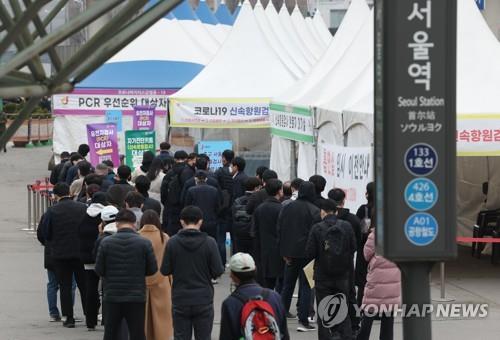- California Assembly OKs highest minimum wage in nation
- S. Korea unveils first graphic cigarette warnings
- US joins with South Korea, Japan in bid to deter North Korea
- LPGA golfer Chun In-gee finally back in action
- S. Korea won’t be top seed in final World Cup qualification round
- US men’s soccer misses 2nd straight Olympics
- US back on track in qualifying with 4-0 win over Guatemala
- High-intensity workout injuries spawn cottage industry
- CDC expands range of Zika mosquitoes into parts of Northeast
- Who knew? ‘The Walking Dead’ is helping families connect
S. Korea’s daily coronavirus cases spike to near 500,000; total caseload surpasses 10 mln
South Korea’s new COVID-19 cases spiked to near 500,000 on Wednesday, adding to concerns that infections continue to spike again as the accumulated caseload surpassed 10 million.
The country had reported 490,881 new COVID-19 infections as of midnight, raising the total caseload to 10,427,247, the Korea Disease Control and Prevention Agency (KDCA) said.

People stand in line to take coronavirus tests at a screening clinic in front of Seoul Station on March 23, 2022.
Wednesday’s tally is the second-highest, after 621,205 new cases reported last Thursday.
The total caseload breached the grim milestone of the 10 million mark Tuesday, meaning 1 out of 5 South Koreans has been infected with COVID-19.
The death toll from COVID-19 came to 13,432, up 291 from Tuesday, the KDCA said. The fatality rate came to 0.13 percent.
The number of critically ill patients stood at 1,084, down 20 from the previous day.
The daily tally has remained over 1,000 for 16 days straight.
As of 9 p.m. Wednesday, the country had reported 380,277 new cases, down 94,999 from the same time the previous day, according to health authorities and provincial governments. Daily cases are counted until midnight and announced the following morning.
Despite an earlier estimate that the current pandemic could peak this week, health authorities cited the possibility of the current outbreak continuing due to the fast spread of the so-called stealth omicron, which has a 30 percent higher transmission rate than the original omicron.
They also cautioned against predictions that COVID-19 infections could be at their peak when 20 percent of the country’s population is infected.
The hospital bed occupancy rate for seriously ill COVID-19 patients came to 64.4 percent Wednesday, down 3.4 percentage points from a day earlier. The rate still remains manageable within the country’s medical response capacity.
The number of people receiving at-home treatment stood at 1,827,031 on Wednesday, the KDCA said.
Of the domestic cases, Seoul reported 101,133 new infections, with the surrounding Gyeonggi Province logging 136,912. The western port city of Incheon reported 24,941.
As of midnight Monday, 32.45 million people out of the 52 million population, or 63.2 percent, had received booster shots. Fully vaccinated people came to 44.46 million, representing 86.6 percent, the KDCA said.











